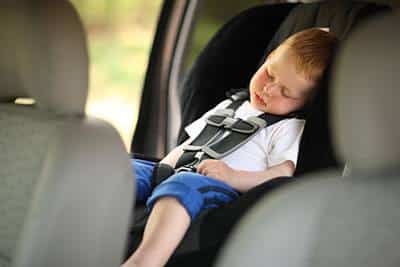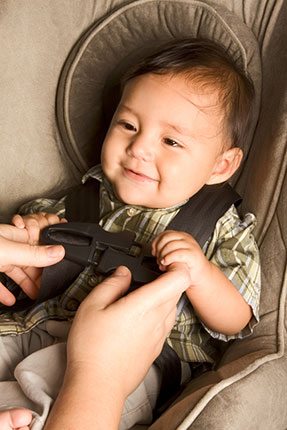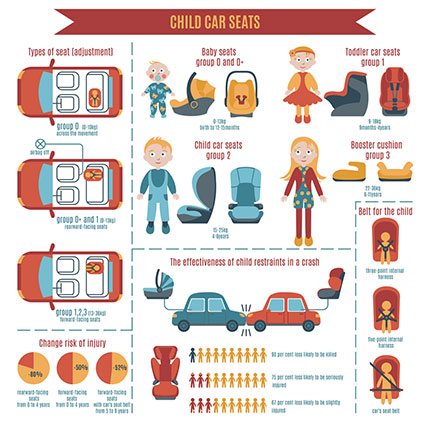Car accidents are the number #1 source of child passenger deaths in children between four and twelve and number #2 in kids aged one to four.
Various studies conducted by the American Academy of Pediatrics and the National Highway Traffic Safety Administration show that placing your child in a correct restraint system is the best way to increase safety.
We will present various car seat facts and stats to discuss the importance of having a child restraint system.
More...
Take away key points
Table of Contents
- Child Restraint System Facts and Stats: What You Need to Know
- 1. Car crash: The leading cause of death in children
- 2. Child safety seats: Children's best protection
- 3. Inadequate car seat installation: Jeopardizing your child's safety
- 4. Proper car seat installation: Saving children's lives
- 5. The most frequent car seat misconceptions
- 6. How to correctly restrain a child in a car seat?
- 7. Car seats meeting your child's age: Age-appropriate restraints for effortless installation
- 8. Car seat laws and standards
- 9. Additional strategies to increase a proper car seat use
- The Bottom Line
Child Restraint System Facts and Stats: What You Need to Know
You're mistaken if you think the game is over once you install a child restraint and place your little one inside. You must keep children's safety a priority on the road to avoid accidents that might result in fatalities.
Look at the statistics below for a better understanding.

1. Car crash: The leading cause of death in children
Car crashes are the most frequent cause of fatally injured children, as the Center for Disease and Control and Prevention claims. The chances that your child will be in a car collision at some point are too high. Understanding how car seat safety can affect the result is crucial to preserve children's lives. Please refer to the facts below:
2. Child safety seats: Children's best protection
When car seats/ booster seats are correctly installed in the back seat of your motor vehicle, the child restraints will prevent serious injury and eliminate fatalities. Look at the numbers for more information.
3. Inadequate car seat installation: Jeopardizing your child's safety
Car seat misuse can severely harm child passengers and result in fatalities. A 2015 NHTSA study showed alarming statistics about incorrect car seat usage, leading to decreased protection and life-threatening situations. The trends show:
4. Proper car seat installation: Saving children's lives

Each car seat has different installation instructions. Consult the instruction manual or contact the manufacturer for in-depth installation guidelines. Here are some additional points to consider when installing a car seat:
5. The most frequent car seat misconceptions
Many parents still do not respect the official guidelines and use car seats in their own way. They are seriously endangering car safety and children's lives. The most common mistakes include:
6. How to correctly restrain a child in a car seat?
The harness straps should be over their shoulders to restrain your child in a car safety seat. The straps mustn't be twisted but lie flat and be pulled through the slots above or at your kiddo's shoulders.
In addition, the chest and harness clip should be tight and buckled until snug. To test the tightness, try pitching the straps at the shoulders. If you cannot pinch it, you're good to go.
If you're unsure how to install a seat properly, please call your verified child passenger safety technician. They will help you with the process and show you all the tips for keeping kids safe in restraints. You can search for the child passenger safety technician here.
7. Car seats meeting your child's age: Age-appropriate restraints for effortless installation
Car seat manufacturers indicate the maximum size and weight limit on the label. So, depending on the size and weight of your kids, you can find the best car seats for all ages and stages.
a. Rear-facing car seat
Rear-facing child restraints are the primary car seats for a baby. Such seats have handles, and you can use them as carriers. Rear-facing seats are turned toward the vehicle's back for increased safety reasons. The AAP recommends using the seats as long as possible; their limit might be 45 or even 50 pounds (extended rear-facing position).
b. Convertible car seats
Depending on your child's size, these restraints can be both forward and rear-facing. The height and weight limit will determine their method. You can use the restraint as the forward-facing seat if the child overcomes the maximum size and weight for the rear seat. Forward-facing limits cover children up to 65 pounds. In addition, these seats have 5-point harness systems for more security.
c. Booster seats
A booster seat is used when the child overgrows the forward-facing harness. Children should be four feet nine inches tall for the booster seat and between eight and twelve years old.
To use the belt-positioning booster seat, you must ensure the seat belt fits the child's body appropriately. For example, the shoulder belt should cover their shoulder and chest, not their neck, while the lap belt must cover their upper thighs and hips, not their stomach. If this is not the case, children are not ready for the belt-positioning booster seats, and you should keep them in the harness seats.
A backless booster seat is another booster seat type. However, the experts prefer the highback booster seat models more, as they provide more head and neck support due to the "wings" on both sides of the frame. Remember to place the booster seat in the vehicle's back until your kids are thirteen.
Finally, the CDC studies show that the death rate in seven years old children was reduced by 25% in all states with booster seat laws compared with states without booster seat laws.
d. Seat belt fit

Once your older children are thirteen, they can use the adult seat belt as the primary restraint system. It would be best to sit in the back, fully restrained, but children can freely sit in the front using the seat belt.
The proper use of seat belts depends on the driver's seat belt. Most children will follow your example, so if you correctly use the belts, your children will do the same. Remember that 65% of child fatalities were due to unrestrained passengers in motor vehicle crashes.
To ensure the seat belt fits properly, the shoulder belt should cover children's chest and shoulders, not their necks. On the other hand, the lap belts must cover their hips and upper thighs, not their stomachs. If not, even older children cannot use seat belts. Even a minor crash can be fatal for incorrectly restrained kids.
8. Car seat laws and standards
Each of America's states has its child restraint rules and law regulations to increase safety on the road. You can find all the car seat laws here. First, however, the most important rules to follow:
9. Additional strategies to increase a proper car seat use
The CDC offers extra programs for improving children's safety on the road and the appropriate use of the restraint system. These include:
Here you can find more about the additional programs.
The Bottom Line
As you have seen, the death rates and trends are alarming. Therefore, parents/caregivers must follow the official rules, car seat facts and stats to increase kids' safety and secure them on the road.
Of course, proper use of child restraint systems is always critical to achieving this goal. So please, ensure the car seats are correctly installed to avoid fatal injuries in car accidents.
